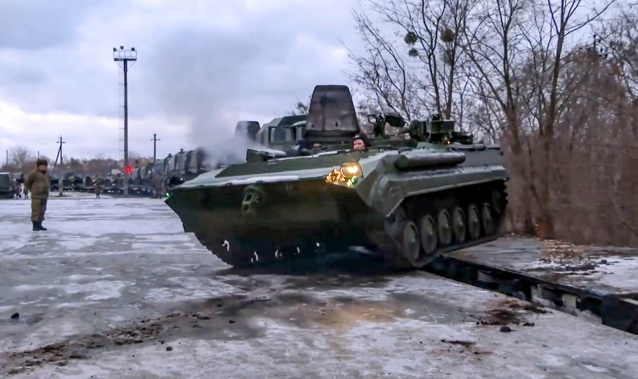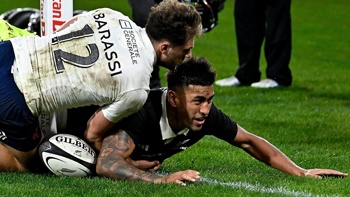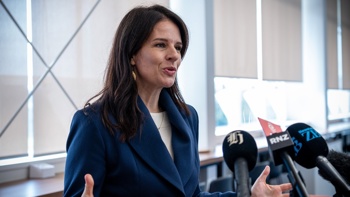
The world's intelligence agencies are warning Russia is on the move. Tanks. Ships. Troops. And the opening moves may have already begun.
Ukraine predicted a massive cyberattack would precede any invasion.
That began this week.
"This is an extremely dangerous situation," White House press secretary Jen Psaki said overnight. "We are now at a stage where Russia could at any point launch an attack."
Russian armoured divisions have moved into the territory of its ally Belarus under the pretext of surprise military manoeuvres. It shares a border with Ukraine, which is relatively poorly defended.
Now Moscow's troopships are assembling in the North Sea. Massive trains full of combat equipment are hauling even more troops from Russia's far east into Europe.
It's a worst-case scenario unfolding before our eyes.
Overnight, Britain's Royal Air Force began an emergency airlift of arms and equipment to reinforce Ukraine. Key among them are FGM-148 "Javelin" guided missiles.
It's hoped the potential of losing hundreds of modern tanks will give President Vladimir Putin pause.
But it may be too little. Too late.
Some 100,000 Russian troops already bracket Ukraine from the north, east and south. But deployments of fresh units to Belarus could place a spearhead just 160km from the capital, Kiev.
They'd also be close to Poland, Lithuania and Latvia. And that's another worst-case scenario. Europe's tiny eastern and northern nations are alarmed. They've caught Russia reinforcing the region with cruise missiles. And Russian troopships are in the process of assembling in the North Sea between Britain and Norway.
Putin's invasion forces are primed and all he needs now is a pretext to attack. Washington warns we may see that soon.
"It is impossible to be sure what Putin is thinking, but Moscow's current behaviour is far from routine," warns Foreign Policy Research Institute analyst Rob Lee.
Putin has painted himself into a corner. Covid is raging. His sanctions-starved economy is constrained. His kleptocrat cronies are increasingly unhappy. And strongmen only survive if they appear strong.
Backing down would be an unacceptable admission of weakness. Strongmen don't surrender. If they do, they get torn down. Fast.
"Russia's threats against Ukraine are more dangerous now because, ultimately, its public threats earlier this year failed," Lee argues. "Russian behaviour suggests that it believes the costs of inaction would be greater than the costs of a significant military escalation in Ukraine."
Ukraine is a matter of Russian pride. It was the economic and cultural jewel of the Soviet Union.
But a national uprising in 2013 rejected a return of Russian influence. So, a year later, Moscow seized the strategically significant Crimean Peninsula and sent unbadged troops to support Ukrainian separatists.
Another seizure seems set to happen.
A massive Russian military build-up began in March last year. Amid diplomatic obfuscation and deliberate misinformation, the force has only continued to grow.
"What I know about the Kremlin and what I know about President Putin is that he is an opportunist and he creates opportunities," a senior US State Department official told reporters. "And so it is incredibly important that when we see these kinds of movements and when there is a concrete change in capabilities, that we acknowledge it and call it for what it is."
Now Putin has put himself within days of war.
The West has crossed his red lines, he says. Now NATO should expect a "military-technical and military" response if his demands are not met.
Britain's secretary for defence Ben Wallace was blunt in his reply. "It is not the disposition of NATO forces but the appeal of its values that actually threatens the Kremlin," he said.
In May, Putin accused Kiev of "purging their political environment". It came after moves to shut down pro-Moscow television channels and internet services run by Putin's close personal friend Viktor Medvedchuk.
He accused Ukraine of becoming "anti-Russia".
Then, in June, Ukraine's parliament formally recognised the region's Indigenous people.
Putin was outraged. It didn't include Russians.
But neither did it include Ukrainians – a fact he conveniently overlooked.
That didn't stop Putin from calling the law a "weapon of mass destruction".
Since then, Putin has suffered a series of public embarrassments.
Britain sent its destroyer through Crimean waters in rejection of Russia's occupation. Moscow was incensed. It claimed to have dropped bombs in the destroyer's path. But this was never substantiated.
Then Ukraine began using Turkish-supplied drones against Russian special forces and insurgents in eastern Ukraine. Moscow had attempted – and failed – to halt the sale of the advanced weapon system to Kiev.
"So, it is not surprising that the Kremlin decided to change its approach," says Lee. "Russia deemed the status quo unacceptable and saw trend lines undermining its position."
Now the warning signs of war are flashing up, one by one.
More troops are on the move. More warships are taking up positions.
Cyberattacks have been unleashed. Propaganda and confusion operations are well underway.
Now US officials say they have evidence of Russia laying the groundwork for a false flag operation that could serve as a pretext for invasion.
Last week, European Union foreign and defence ministers held a meeting in Brest, France.
"There is a real risk of a new armed conflict in Europe," NATO Secretary-General Jens Stoltenberg said.
"The United States and our allies are prepared for any contingency, any eventuality," US national security adviser Jake Sullivan added on Friday. "We're prepared to keep moving forward down the diplomatic path in good faith, and we're prepared to respond to fresh acts.
"And beyond that, all we can do is get ready. And we are ready."
Kiev has been seeking to strengthen its relatively small army. It's been striving for international support.
Up to 2000 Javelin antitank missiles were flown yesterday into the beleaguered nation by British military aircraft. These weapons will give Ukrainian soldiers a much greater chance of success when facing Russia's masses of tanks and armoured personnel carriers.
They won't be enough to stop an assault.
But they may be enough to threaten the swift, low-cost war Putin needs for political success. Meanwhile, Moscow has rejected US accusations it is preparing a staged incident to act as an excuse for invasion.
US intelligence officials have warned that Russia had already deployed undercover operatives to rebel-controlled eastern Ukraine. Their alleged mission is to carry out acts of sabotage and blame them on Kiev.
Yesterday, Russian Foreign Minister Sergey Lavrov accused the US of taking a page out of Moscow's own playbook – that of "total disinformation".
He reaffirmed Moscow's deadline of this week for a written guarantee that NATO will not accept any further former Soviet states into its fold. Even though Moscow's own aggressive behaviour is driving them there.
Moscow continues to threaten "unspecified action" if the US and NATO don't agree to its demands, including refusing membership for Sweden.
"Russian officials are backing themselves into a corner by committing themselves to a strong response unless they receive concessions," warns Lee. "If it does not achieve some of its stated goals, Moscow will suffer a cost to its credibility if it does not escalate."
- By Jamie Seidel, news.com.au
Take your Radio, Podcasts and Music with you









